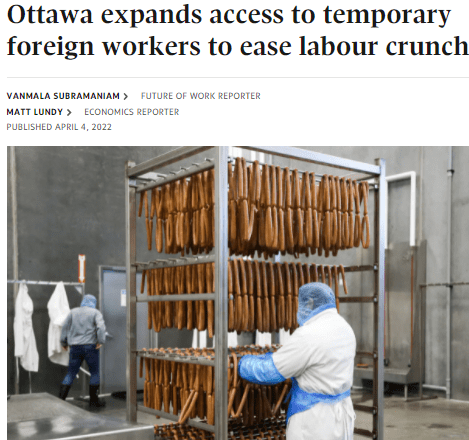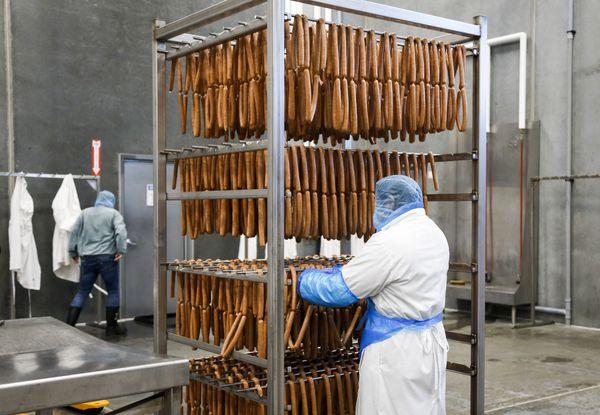The federal government is allowing Canadian employers to hire significantly more temporary foreign workers as part of changes to its immigration rules, a move aimed at easing labour shortages that have aggravated businesses during the recovery from the pandemic.
The federal employment ministry announced changes to the Temporary Foreign Worker Program on Monday that will ultimately increase the number of TFWs allowed into Canada, both in low- and high-wage jobs. The changes will also streamline the application process for employers.
The loosened restrictions deliver a boon to businesses just days before the release of the 2022 federal budget, which corporate Canada will be watching closely for measures aimed at growing Canada’s economy after two years of market gyrations and massive public spending.
Starting on April 30, employers will be allowed to increase the number of low-wage TFWs they hire, from 10 per cent to 20 per cent of their total workforces, until further notice. For seven key sectors that have suffered from particularly acute labour shortage issues over the past few years – such as food manufacturing; hospitals, nursing and residential care; and accommodation and food services – the TFW cap for low-wage workers will be raised to 30 per cent for one year.
The government is also planning to remove a cap on the number of low-wage positions that employers in seasonal industries, such as fish and seafood processing, can fill through the program. Employers will now be able to keep TFWs in these positions for 270 days, instead of the current 180 days.

In addition, the government is expanding the duration of time that a foreign worker hired through the Global Talent Streams program (which is geared at high-wage foreign workers) can be employed in Canada, to three years from two. Technology leaders in Canada have continually lobbied Ottawa to loosen immigration rules for high-skilled workers, because the battle for tech talent often pits domestic firms against deep-pocketed Silicon Valley giants.
Many businesses in Canada, particularly those that were impacted by on-and-off lockdowns over the past two years, have been struggling to find domestic workers willing to be employed on the front lines of an ongoing pandemic, and have been calling on the government to allow them to access the TFW program.
Canadian employers were recruiting for roughly 915,000 positions in the fourth quarter of 2021, an increase of 80 per cent over the number of openings two years prior, according to Statistics Canada. In December, the labour need was particularly acute in three industries, each of which had more than 100,000 open positions: accommodation and food services, retail, and health care and social assistance.
Even as demand for labour has increased, employment in Canada has jumped above prepandemic levels. The national unemployment rate is 5.5 per cent, putting it just shy of a record low – a sign that worker availability is waning.

“As we begin to recover from the pandemic and look to fill remaining job vacancies, we will continue to make our Temporary Foreign Worker Program more accessible, efficient and agile to support employers who are looking to staff up and grow their operations,” Sean Fraser, the federal Minister of Immigration, Refugees and Citizenship, said in a statement.
TFWs are allowed into Canada on temporary visas, and they usually face legal restrictions on where they can work and the types of labour they can perform. A TFW can try to gain permanent residency in Canada, but those who aren’t granted permanent status are required to leave the country when their visas expire.
The expansion of the TFW program was met with mixed reactions. Employers and business lobby groups applauded the changes, while labour advocates cautioned that increasing the number of TFWs effectively increases the number of precarious workers with fewer rights than Canadians.
“We feel like the business community has been heard around labour shortages, particularly in the short term,” said Leah Nord, senior director of workforce strategies and inclusive growth at the Canadian Chamber of Commerce. The TFW program changes are “going to go a long way to help address those issues in many sectors.”

For decades, the TFW program has been a focal point of criticism in Canada’s immigration system. Its opponents have said it is overused by companies looking to drive down labour costs. Another frequent criticism is that the program allows employers to exploit migrant workers.
Only 0.4 per cent of Canada’s overall labour force consists of workers from the TFW program, according to the government. Most end up working in low-wage jobs. Agriculture alone accounts for 60 per cent of all TFWs.
Seasonal agriculture workers often live in employer-provided bunkhouses. Those crowded conditions have been blamed for a rash of COVID-19 outbreaks among migrant workers over the past two years, resulting in thousands getting sick and some dying. Labour groups say inhumane treatment of agricultural workers is acute in Ontario, where they are barred from unionizing or entering into collective bargaining agreements.
“This is very concerning. When workers come into this country tied to an employer, it completely limits their ability to speak up about any unfair labour practices or health issues,” said Deena Ladd, executive director of the Workers’ Action Centre, a labour advocacy group.
Ms. Ladd added that allowing an influx of foreign workers to enter the country without a clear path toward permanent residency, which would give them full labour and health protections under the law, is regressive.
The government has said increasing the Global Talent Streams visa period to three years from two will allow this class of foreign worker to more easily find ways to qualify for permanent residency.
Jane Deeks, a spokesperson for Carla Qualtrough, the Minister of Employment, Workforce Development and Disability Inclusion, said nearly 152,000 applicants transitioned from worker status to permanent residency between January and November of 2021.
Source: https://www.theglobeandmail.com/business/article-ottawa-loosens-restrictions-on-temporary-foreign-workers/

